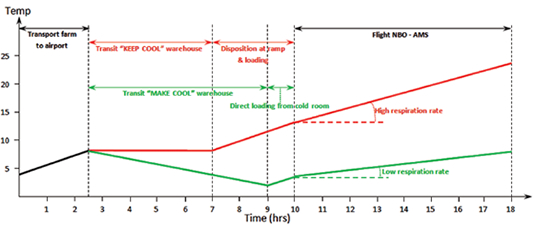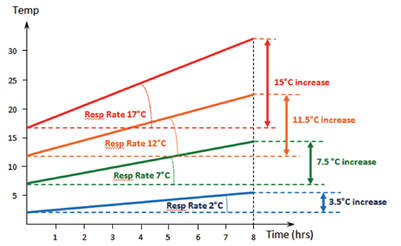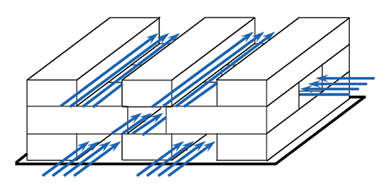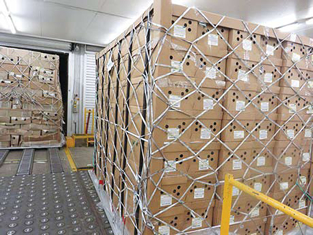Scientific facts in cold chain management  Although a scientific approach of post harvest technology for fruits, vegetables and flowers goes back to the 1970’s, many partners in the logistic chain still lack awareness and knowledge of basic principles. All efforts that the producer has made to reach top quality products may be lost within 24 hours by mismanagement of the cold chain. The small gain made by saving on the cold chain is negligible compared to the loss of value it will cause. Proper cold chain management from farm till buyer is an essential condition for the preservation of the quality and the value of a perishable product.
Although a scientific approach of post harvest technology for fruits, vegetables and flowers goes back to the 1970’s, many partners in the logistic chain still lack awareness and knowledge of basic principles. All efforts that the producer has made to reach top quality products may be lost within 24 hours by mismanagement of the cold chain. The small gain made by saving on the cold chain is negligible compared to the loss of value it will cause. Proper cold chain management from farm till buyer is an essential condition for the preservation of the quality and the value of a perishable product.
The respiratory metabolism
Cut flowers, harvested fruits and vegetables are still alive and carry on characteristic processes of all living things. The most important process is the respiratory metabolism. It is a natural process of ripening, senescence and deterioration of the plant. The bio-chemical reaction (for 1 mole): C6H12O6 + 6O2 + 6CO2 + 6H2O + 686 kcal 294 kcal of the produced energy is used for internal processes but 392 kcal is heat. Cut flowers, beans and the vast majority of Kenyan fresh produce are climacteric plants and have a very high respiration rate. The respiration is triggered by ethylene, a self-regulatory hormone produced by the plant itself.
Without a doubt the most important factor affecting postharvest life is temperature. The temperature has a profound effect on the rates of biological reactions, the metabolism and the respiration.Increased temperatures cause an exponential rise in respiration. The “Van’t Hoff” rule states that the velocity of a biological reaction increases 2 to 3-fold for every 10°C rise in temperature.
At 0°C the respiration ceases. But storing fresh products at freezing point may cause damage. Freight forwaders should maintain and monitor a constant temperature of 2°C, avoiding frost damage but keeping the respiration at very low rate.
As the respiratory metabolism is an exothermic reaction (producing heat) and the process rate is not a linear but an exponential function of the temperature, it is of major importance to keep the temperature as low as possible. In particular during periods of little or no temperature control (trucking, flight) a low temperature at the start of the period is mandatory. The diagram on the next page shows clearly the cumulative effect of a high start temperature and the increased respiration rate at high temperatures. A load at 2°C may increase to 5.5°C over a period of 8 hours; a load starting at 17°C will increase to 32°C.
“Make Cool” and “Keep Cool”
Cold chain management is not just an initial condition but requires permanent care from harvesting to final consumption. As ripening, senescence and fungal and bacterial infections arise whenever the temperature goes up, cold chain management is a sequence of “making cool”, “keeping cool” and “making cool again”.
 The design of a “make cool” cold store is different from a normal “keep cool” facility. Much more critical parameters have to be considered. The room must have sufficient volume and have sufficient refrigerators. The dimensional layout and the positioning of the refrigerators must create a strong, steady and equal spread flow of cold air. Before design and construction, Freight forwaders cold facilities should be based on academic research, practical knowledge in cold chain management and years of experience in construction technology of cold store facilities.
The design of a “make cool” cold store is different from a normal “keep cool” facility. Much more critical parameters have to be considered. The room must have sufficient volume and have sufficient refrigerators. The dimensional layout and the positioning of the refrigerators must create a strong, steady and equal spread flow of cold air. Before design and construction, Freight forwaders cold facilities should be based on academic research, practical knowledge in cold chain management and years of experience in construction technology of cold store facilities.
Apart from adequate facilities there is need to implement proper procedures on the handling of the perishables. Upon acceptance at the premises boxes should be stack on small aluminium pallets leaving wide tunnels for the cooling air flow. With spacious cold store, pallets should be stored separately, not adjacent to each other. If delivery deadlines are respected temperatures of the fresh produce should be brought back to 2°C before build up on the ULD. In case of late delivery or extreme high temperature (ex. transit goods) shipments should be pre-cooled to 2°C in 45 minutes. Good cold chain management requires attention to the details, ULD’s should be cooled before build up.
Another important advantage of the steady cool air flow is the ventilation. Flowers, fruits and vegetables produce ethylene gas and the respiratory metabolism produces water. Germs of bacterial and fungal infection may already be present before harvest. (botrytis, anthracnose a .o.) They may be in a state of dormancy and will occur when the conditions are ideal to develop. Harvested plants have a reduced natural resistance against infections. In combination with the rise in temperature and the presence of moisture infection may arise quickly. The air flow will prevent condensation and create an unfavourable environment for infection development. Condensed moisture may also affect the strength of the packaging.
Weak links in the cold chain
Unfortunately there are periods in the logistic chain with little control over the cold chain. Producing farms and final consumers are not located at the airport and airplanes have limited cooling capacities. When boxes are stacked against each other the cold air flow cannot reach the inner boxes. As the respiratory metabolism is a self-regulatory chemical reaction, the process heat will cumulate inside of the stack. This fact emphasizes the importance of a low starting temperature and the need of a corrective “make cool again” period at the end of the weak link.
Upon arrival of the trucks at the acceptance area high temperatures are registered despite the fact that the trucks are refrigerated. Obviously no one can undo past processes but the progress of the biochemical reactions can be stopped. Within a normal transit at the facilities the temperature can be brought back to 2°C prior start of build up for the flight.
Once an aircraft pallet is built up with perishables, even when stored in a cold environment, you can only control the outside of the pallet. The processes inside the pallet are not controllable anymore. Hence you cannot build pallets too long in advance of the flight and build up should be done in perfect temperature conditions.

It is of great importance to reduce the uncontrollable periods in the logistic chain. On board of the aircraft, where pallets are adjacent to each other and the total mass is large, the air flow cannot penetrate to the middle of the pallets. Obviously a good cooling system in the aircraft can slow down the heat production but it cannot stop it. Logically the shorter the flight the less heating will occur. Direct non-stop flights perform better than flights that make a transit stop. An uncontrollable transit time, often minimized by second line handlers, is the transport to the cargo ramp and the line up before loading. As ULD’s are towed by 4 or 5 each time this operation takes hours.
During this period goods are exposed to ambient temperatures and sometimes adverse weather conditions. The use of thermal covers has no efficiency as the heat and ethylene is produced inside the pallet. If flights are delayed the situation worsens. In case of cancellation the pallets need to be towed back to the second line cold store. Logically this will cause heavy consequences on the cold chain management.
It is adviseable to use facilities located airside, right in front of the cargo apron where loading is done. Loading can easily be done straight from the cold room to the aircraft. It the least time of goodwill from the loadmaster to enter the cold room and specify the loading sequence.
Adding up the differences
Cold chain management is permanent care. Take preliminary action prior periods of poor control, make cool again when the temperature has increased, reduce the uncontrollable periods whenever possible and eliminate conditions for fungal or bacterial infections. Every care, even a minor attention, contributes to the preservation of quality and value of the product.
The airside location of the cold store, the high standard facilities and the appropriate handling procedures should be considered before making decision on the best supplier of perishable handling services at the airport. The suppliers should be dedicated to cold chain management with activities restricted to the handling of perishable export. This will ensure no concerns and no conflicting deadlines with import traffic, general export or ramp handling.
Changing markets  The supply chains of flowers and fresh produce are changing. Apart from the traditional sale through auctions to wholesalers and retailers, the direct sale to mass market retailers has gained considerable importance. Mass-markets retailers often apply more stringent standards on quality and tend to focus more on quality and reliability than on price. The horticultural export industry is highly internationalized and the region faces permanent competition from leading producer countries like Colombia and Ecuador. Over the last years there has been a remarkable increase of cargo capacity, resulting in periodic overcapacity and reductions of the airfreight rates. Where most of the traditional carriers offered direct services some of the new players operate routes with a stopover. If pricing becomes the only ammunition on the battlefield of competition the horticultural export may become a war cemetery. Being fixated only on lower pricing it is hard to see that at the end of the supply chain the trend is for higher quality. With 40 years of experience in horticultural production and export Kenya has a considerable advantage to its neighbours when it comes to quality. But to keep a sustainable leading position on the market the Kenyan horticultural industry will have to cope with the demands for high standards at the end of the supply chain. More than pricing, quality and reliability are becoming the main criteria.
The supply chains of flowers and fresh produce are changing. Apart from the traditional sale through auctions to wholesalers and retailers, the direct sale to mass market retailers has gained considerable importance. Mass-markets retailers often apply more stringent standards on quality and tend to focus more on quality and reliability than on price. The horticultural export industry is highly internationalized and the region faces permanent competition from leading producer countries like Colombia and Ecuador. Over the last years there has been a remarkable increase of cargo capacity, resulting in periodic overcapacity and reductions of the airfreight rates. Where most of the traditional carriers offered direct services some of the new players operate routes with a stopover. If pricing becomes the only ammunition on the battlefield of competition the horticultural export may become a war cemetery. Being fixated only on lower pricing it is hard to see that at the end of the supply chain the trend is for higher quality. With 40 years of experience in horticultural production and export Kenya has a considerable advantage to its neighbours when it comes to quality. But to keep a sustainable leading position on the market the Kenyan horticultural industry will have to cope with the demands for high standards at the end of the supply chain. More than pricing, quality and reliability are becoming the main criteria.
Article Courtesy of Edited Presentation From Triple FFF and FlowerWatch Ltd Presentation
